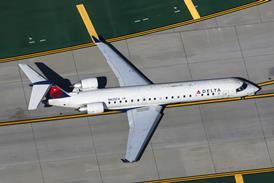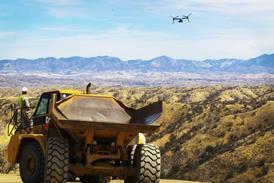A US coast-to-coast capability was a key selling point when Bombardier launched the Continental here at Paris in 1999. Four years later the super-midsize jet now known as the Bombardier Challenger 300 makes its Paris debut complete with FAA certification - and a world record transcontinental flight as well.
Five days ago the test flight aircraft 20-005, aircraft seen here on the static, flew from Miami, Florida to Seattle, Washington. The flight lasted 5hr 48 minutes. The aircraft cruised at Mach 0.8 at a maximum cruising level of 45,000ft (13,700m) establishing a new record for the 2,724 mile (4,386km) route.
ReservesWind conditions were light throughout the flight and the aircraft landed in fairly light rain in Seattle with more than adequate fuel reserves according to Bob Agostino, director of flight operations, Bombardier Aerospace, Business Aircraft, who was pilot-in-command on the flight.
Says Agostino: "The flight clearly demonstrates the true coast-to-coast range of the Challenger 300 with eight passengers. We purposely selected a difficult route and purposely selected passengers that truly represent a typical passenger profile. The aircraft performed very, very well." The aircraft subsequently flew from Boston, Massachusetts to arrive in Paris in 6hr 3min.
Bombardier believes the aircraft fills a gap in the emerging super-midsize market. Prior to the launch four years ago the Canadian manufacturer undertook what it terms "unprecedented" market research. This included more than 350 questionnaires and personal interviews with over 100 company chief executives.
The result was, according to John Holding, executive vice president, engineering and product development, a "demanding brief" for an aircraft that could "bridge the gap between the Learjet 60 and Challenger 604". Developing an aircraft that could plug the $10 million price gap between the two required a new design.
Holding explains that from the outset neither stretching the former nor shrinking the latter was an option.
"We have a clean sheet product with clean sheet power plant. This is a workhorse aircraft. It needs to be easy to maintain.
Thrust"The Honeywell AS907 engines, which deliver 28.9kN of thrust, are performing exceptionally well. We haven't had any engine hiccups in testing and they're meeting all our performance requirements.
"The fact that the engines were designed with regional aircraft in mind is significant in terms of keeping maintenance costs down." The aircraft will be RVSM certified on entry into service later this year.
Bombarider's belief was that it could deliver a large cabin aircraft with lower direct operating costs than anything else in the super-midsize category.
It has unveiled a aircraft which it claims has operating costs of $770 per hour a range of 5,741km, a balanced field length of 4,950ft, a speed of Mach 0.8 - and a price tag at launch of $14.25 million. Internally it offers an 8.72m long cabin with a max width of 2.19m and 1.85m height. Total floor area is 13.56m2.
The aircraft is offered with a ten year warranty on the airframe and five years on engines and avionics. With training key to the long-term sales success of the project Bombardier says it has invested heavily in training and will have level D simulators functional "early" in the service life of the aircraft.
Peter Edwards, president of Bombardier Business Aircraft, says he's delighted with the aircraft.
"It's competitively priced, it offers true transcontinental range and superior long-range speed, combined with a full eight-passenger cabin and operating costs better than current mid-size jets. This aircraft will define the super-midsize category."
He believes his development team has met all the demanding criteria set - and kept the programme on schedule despite the downturn in the industry.
Source: Flight Daily News























